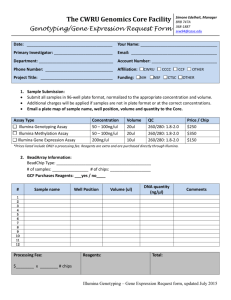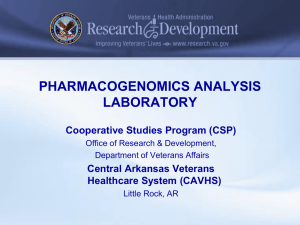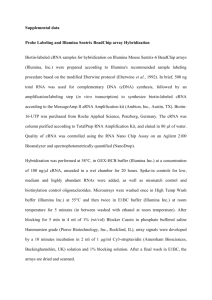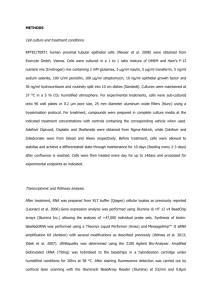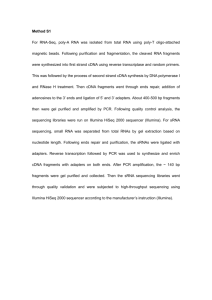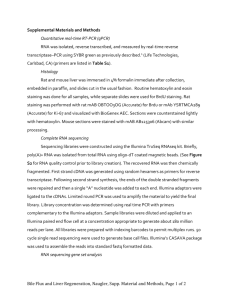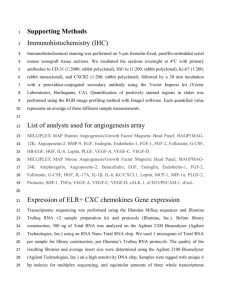PHS 398 (Rev. 6/09), Resources Format Page
advertisement
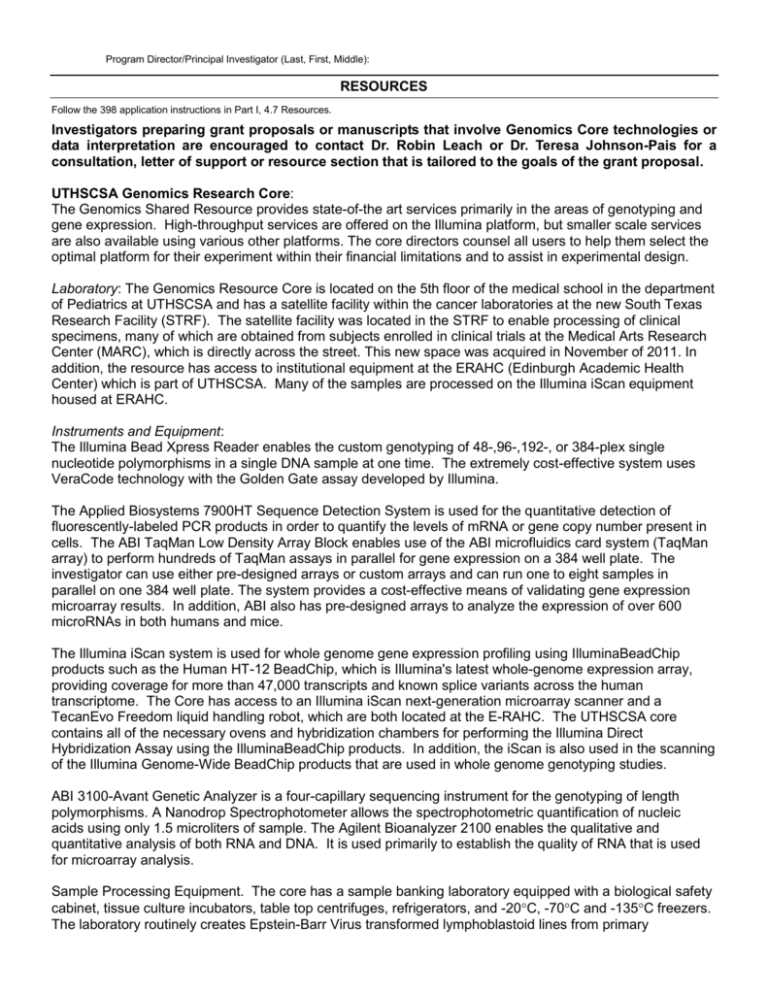
Program Director/Principal Investigator (Last, First, Middle): RESOURCES Follow the 398 application instructions in Part I, 4.7 Resources. Investigators preparing grant proposals or manuscripts that involve Genomics Core technologies or data interpretation are encouraged to contact Dr. Robin Leach or Dr. Teresa Johnson-Pais for a consultation, letter of support or resource section that is tailored to the goals of the grant proposal. UTHSCSA Genomics Research Core: The Genomics Shared Resource provides state-of-the art services primarily in the areas of genotyping and gene expression. High-throughput services are offered on the Illumina platform, but smaller scale services are also available using various other platforms. The core directors counsel all users to help them select the optimal platform for their experiment within their financial limitations and to assist in experimental design. Laboratory: The Genomics Resource Core is located on the 5th floor of the medical school in the department of Pediatrics at UTHSCSA and has a satellite facility within the cancer laboratories at the new South Texas Research Facility (STRF). The satellite facility was located in the STRF to enable processing of clinical specimens, many of which are obtained from subjects enrolled in clinical trials at the Medical Arts Research Center (MARC), which is directly across the street. This new space was acquired in November of 2011. In addition, the resource has access to institutional equipment at the ERAHC (Edinburgh Academic Health Center) which is part of UTHSCSA. Many of the samples are processed on the Illumina iScan equipment housed at ERAHC. Instruments and Equipment: The Illumina Bead Xpress Reader enables the custom genotyping of 48-,96-,192-, or 384-plex single nucleotide polymorphisms in a single DNA sample at one time. The extremely cost-effective system uses VeraCode technology with the Golden Gate assay developed by Illumina. The Applied Biosystems 7900HT Sequence Detection System is used for the quantitative detection of fluorescently-labeled PCR products in order to quantify the levels of mRNA or gene copy number present in cells. The ABI TaqMan Low Density Array Block enables use of the ABI microfluidics card system (TaqMan array) to perform hundreds of TaqMan assays in parallel for gene expression on a 384 well plate. The investigator can use either pre-designed arrays or custom arrays and can run one to eight samples in parallel on one 384 well plate. The system provides a cost-effective means of validating gene expression microarray results. In addition, ABI also has pre-designed arrays to analyze the expression of over 600 microRNAs in both humans and mice. The Illumina iScan system is used for whole genome gene expression profiling using IlluminaBeadChip products such as the Human HT-12 BeadChip, which is Illumina's latest whole-genome expression array, providing coverage for more than 47,000 transcripts and known splice variants across the human transcriptome. The Core has access to an Illumina iScan next-generation microarray scanner and a TecanEvo Freedom liquid handling robot, which are both located at the E-RAHC. The UTHSCSA core contains all of the necessary ovens and hybridization chambers for performing the Illumina Direct Hybridization Assay using the IlluminaBeadChip products. In addition, the iScan is also used in the scanning of the Illumina Genome-Wide BeadChip products that are used in whole genome genotyping studies. ABI 3100-Avant Genetic Analyzer is a four-capillary sequencing instrument for the genotyping of length polymorphisms. A Nanodrop Spectrophotometer allows the spectrophotometric quantification of nucleic acids using only 1.5 microliters of sample. The Agilent Bioanalyzer 2100 enables the qualitative and quantitative analysis of both RNA and DNA. It is used primarily to establish the quality of RNA that is used for microarray analysis. Sample Processing Equipment. The core has a sample banking laboratory equipped with a biological safety cabinet, tissue culture incubators, table top centrifuges, refrigerators, and -20C, -70C and -135C freezers. The laboratory routinely creates Epstein-Barr Virus transformed lymphoblastoid lines from primary lymphocytes. Life Technologies Ion Torrent is a cost-effective, next-gen sequencer used for the following applications; 1) small genome sequencing, 2) targeted amplicon resequencing, 3) sequencing of bar-coded libraries, 4) validation of whole genome/whole exome sequencing data, 5) library assessment for next-gen sequencing platforms, and 6) whole transcriptome sequencing. Services Genotyping Services 1. Illumina GoldenGate multiplex high-throughput single nucleotide polymorphism (SNP) genotyping is accomplished using the Illumina’s GoldenGate technology on either the Illumina’s BeadXpress or Illumina’s i-Scan platforms. 2. Whole Genome-wide Genotyping of SNPs uses Illumina’s Infinium HD assay with the Omni series of microarrays. 3. Applied BiosystemsTaqMan SNP genotyping. 4. Length Polymorphisms are assayed on the ABI 3100-Avant Genetic Analyzer. 5. Copy number variants (CNV) detection using various methods. Gene Expression Services 1. Illumina whole genome expression using BeadChip products and the i-Scan platform. 2. Applied BiosystemsTaqMan gene expression. 3. HTG molecular miRNA arrays. 4. The ABI Taqman low density array for gene expression on one 384 well plate. In addition, ABI also has pre-designed arrays to analyze the expression of over 600 microRNAs in both humans and mice. Sample Banking Services 1. Immortalization of human lymphocytes. The cell line use to prepare the EBV stock is tested for the presence of Mycoplasma. 2. Expansion of existing lymphoblastoid cell lines. 3. DNA and RNA isolation and processing of other biologics, including plasma, serum and isolating peripheral blood mononuclear cells from blood. 4. Long-term storage of frozen samples. Personnel: Robin J. Leach, Ph.D., is the overall director of the Genomics Shared Resource. Dr. Leach is a Professor in the Department of Cellular and Structural Biology as well as in the Department of Urology. She has been directing a core facility for the cancer center since 1999, although originally the focus of the facility was primarily cytogenetic and cell banking. She has over 30 years of experience in the field of molecular genetics. Teresa Johnson-Pais, Ph.D., is the co-director of the institutional genomics core and serves as a consultant to this shared resource. She is an Associate Professor in the Department of Pediatrics and has a long history of collaborating with Dr. Leach and her laboratory group. She has 20 years of experience in the field of molecular genetics and cell banking and assistant in the day-to-day management of genotyping and banking aspects of the core. Carolina Livi, Ph.D., is the director of gene expression for the institutional core. She is an Assistant Professor in the Department of Molecular Medicine and works closely on numerous genetic projects. In addition to her extensive experience in gene expression, she has substantial training in computational biology and assists many of the core users in the preliminary assessment of their expression data. PHS 398 (Rev. 6/09) Page Resources Format Page
